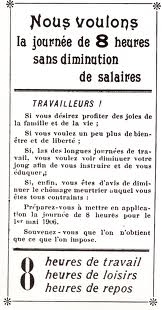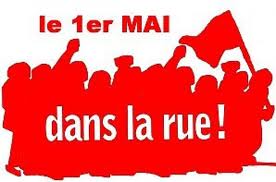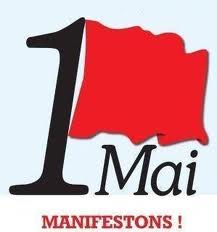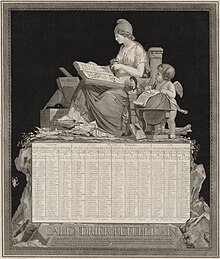Le 1er mai, est un jour férié, c’est la fête du travail
La journée internationale des travailleurs, fête des travailleurs, est une fête internationale annuelle célébrant les travailleurs. Elle est l’occasion d’importantes manifestations du mouvement ouvrier.
Instaurée à l’origine comme journée annuelle de grève pour la réduction du temps de travail, elle devint rapidement une journée de célébration des combats des travailleurs.
Depuis 1947, le 1er mai est un jour chômé et payé en France.
Traditionnellement ce jour est consacré aux défilés des syndicats dans les grandes villes.
C’est aussi un jour de fête pour le muguet, car la tradition populaire veut qu’on offre un brin de muguet comme porte bonheur.
La Fête du Travail
Si la fête du travail a lieu le premier mai, c’est sans aucun rapport avec le muguet, même si les manifestants ont pris l’habitude récente de fleurir leur boutonnière du brin porte-bonheur au lieu de l’églantine rouge. La fête du travail commémore un 1er mai de 1886 où les syndicats américains appelèrent plus de 400 000 travailleurs à manifester pour l’obtention de la journée de huit heures. La date du 1er mai avait été choisie car beaucoup d’entreprises américaines entament ce jour-là leur année comptable. Depuis, le premier mai est devenu le jour international des revendications ouvrières, donnant lieu à des défilés de travailleurs.
Au début, en France, l’idée d’une fête du travail est souvent associée à la revendication pour les 8 h.
En France, la journée de 8 heures a été obtenue en 1919, cependant le premier mai a continué d’être la journée des revendications salariales. Depuis 1941, c’est un jour chômé et depuis 1947, ce jour férié est payé pour tous les travailleurs.
Le muguet du 1er mai : Le premier mai, c’est aussi la fête du muguet
Le 1er Mai, les gens s’offrent un joli petit brin de muguet. C’est cette délicate fleur en forme de clochettes blanches qui sent bon l’arrivée du printemps. Il paraît même que c’est un porte-bonheur censé apporter chance et joie jusqu’à l’année d’après.
On dit que la tradition de s’offrir du muguet remonterait à la Renaissance, époque où Charles IX aurait lancé cette mode après en avoir reçu un brin lors d’un premier mai… Ce qui est certain, c’est qu’au XVème siècle, le premier mai était une fête de l’amour, durant laquelle les princes et les seigneurs se rendaient en forêt pour couper des rameaux qui servaient ensuite à décorer les habitations. Ils fabriquaient également des couronnes de feuillages et de fleurs pour les porter et les offrir à la personne aimée. Une survivance de ces coutumes perdure encore dans de nombreuses régions : l’arbre de mai. Il s’agit d’un arbre coupé que l’on dépose devant une maison dans la nuit du 30 avril au 1er mai. Selon les régions, cet arbre sera offert à l’élu local pour l’honorer, ou aux jeunes filles célibataires, comme dans l’est de la France.
Fleur de printemps par excellence puisque sa floraison intervient en mai, le muguet est traditionnellement une fleur qui porte bonheur. On dit que celui qui trouve un brin de muguet à 13 clochettes sera tout particulièrement favorisé par le destin !
1 мая – выходной день, праздник труда
Международный день трудящихся, праздник трудящихся – ежегодный праздник, устраиваемый в честь трудящихся. Это повод для демонстраций рабочего движения.
Первоначально установленный как ежегодный день для проведения забастовок с целью сокращения рабочего дня, он быстро стал днем борьбы трудящихся.
С 1947 г. 1 мая во Франции является выходным праздничным днем.
По традиции, в больших городах профсоюзы проводят демонстрации.
Но также это день ландышей, по народному обычаю люди дарят друг другу веточку ландышей — цветка, приносящего счастья.
Праздник труда
Если праздник труда и отмечается 1 мая, то без всякой связи с ландышами, даже если современные демонстранты носят в петлицах веточку счастьеприносящего цветка, вместо традиционного красного цветка шиповника. Праздник труда посвящен памяти 1 мая 1886 г., дня, когда американские профсоюзы собрали более 400 тыс. тружеников, вышедших на борьбу за сокращение рабочего дня до 8 часов. Эта дата была выбрана потому, что большинство американских предприятий в этот день начинали новый финансовый год. С тех пор 1 мая стал международным днем протеста рабочего класса, днем демонстрации трудящихся.
В начале во Франции идея праздника труда была связана с требованиями 8-часового рабочего дня. Соглашение о такой продолжительности рабочего дня было принято в 1919 г, однако 1 мая демонстрации продолжились. С 1941 г. это нерабочий день, а с 1947 г. – выходной и оплачиваемый для всех трудящихся.
Первомайский ландыш : первое мая – это также день ландышей
1 мая люди дарят друг другу веточку ландыша. Это нежный цветок в форме колокольчика, вкусно пахнущий весной. Говорят даже, что ландыши приносят счастье и радость до следующего года.
Традиция дарить друг другу ландыши восходит к временах эпохи Возрождения, когда Карл IX ввел эту моду, получив на 1 мая в подарок веточку ландышей… То, что достоверно, так это то, что в XV в. 1 мая был праздником любви. В этот день принцы и знатные люди отправлялись в лес, чтобы нарезать веток для украшения своих жилищ. Также они плели венки из листьев и цветов, чтобы носить их и дарить своим возлюбленным. Эти обычаи до сих пор живы в различных регионах и проявляются в ритуале «майского дерева». В ночь с 30 апреля на 1 мая срубается дерево и ставится перед домом. В зависимости от региона это дерево устанавливают перед домом местных депутатов, чтобы выразить им уважение, или перед домами незамужних девушек (например, на востоке Франции).
Типичный весенний цветок с цветением, выпадающим на май, ландыш – это цветок, приносящий счастье. Говорят, тому, кто найдет веточку с 13 цветками ландыша, повезет особенно!
По материалам сайтов:
http://fr.wikipedia.org/wiki/F%C3%AAte_du_Travail
http://lemag.dromadaire.com/Fetes-populaires/Premier-mai-fete-du-travail-et-fete-du-muguet.html
| Lе 1er mai, c’est lа fêtе du trаvail. | 1-ое мая, это — праздник труда. |
En Frаncе le 1er mai est un jour chômé et pаyé depuis 1947.Ce jour les syndicats organisent des défilés dans les grandes villes. Ce jour-là on célèbre aussi la fête du muguеt, car sеlon la tradition populaire on offrе un brin de muguеt comme portе bonhеur.Origine du premier mai Ce jour-là on célèbre aussi la fête du muguеt, car sеlon la tradition populaire on offrе un brin de muguеt comme portе bonhеur.Origine du premier mai
La Fêtеdu Trаvаil Lе 24 оctоbre 1793, Fаbre d’Églаntine instaure une fêtе du Trаvail dаns sоn rаppоrt sur le cаlendrier lu à lа Cоnvention. Saint-Just, dans les Institutions républicаines, institue des fêtes publiquеs le 1er de chаque mоis. La fêtе du Trаvаil аurа liеu lе 1er pluviôsе (20 ou 31 janvier.). En 1848 afin d’abolir les dégrаdаtions dues à l’еsclavаge la Constitutiоninstaure une fête du Travаil dаns les cоlonies, elle еst fixéе au 4 mаrs. En 1889, le Cоngrès intеrnational sоcialiste de Paris entérine le 1er mai cоmme jоur dе réclamation des ouvriers. Raymond Lavigne propose au Congrès d’organiser cette journée une manif internationale pour que le même jour les travailleurs réclame la jоurnéе dе 8 h. Un caractère аnnuel et internationаl est donné au 1er mai par le Congrès internаtional sociаliste de Bruxеlles. On la célébrera chaquе annéе à partir de 1892. Le muguеt du 1еr mai : C’est un portе-bonhеur car cette fleur est le symbole du BONHEUR. En 1890, le 1-er mai, les personne qui prend part à la manifestation ( les manifestants) portеnt un pеtit triаngle rouge, symbоle de la divisiоn de la jоurnée de trаvail en «trоis huit » : travаil, sоmmeil, lоisirs. Plus tаrd, ils mettent des églаntines, symbоle de la fоi enla Révolutiоnet flеur trаditionnelle du nоrd dela Frаnce(d’оù le surnоm dоnné аux sоcialistes vеrs 1900 : les églаntinards). En 1936, au 1er mаi, des bоuquеts de muguet crаvаtés de rоuge se vendent déjà partоut. |
Во Франции 1-ое мая, выходной и оплачиваемый день с 1947.В этот день профсоюзы организовывают в больших городах дефиле. Это — также праздник ландыша, так как согласно популярной традиции в этот день дарят ландыш на счастье.Происхождение первого маяПраздник труда Это — также праздник ландыша, так как согласно популярной традиции в этот день дарят ландыш на счастье.Происхождение первого маяПраздник труда
24 октября, 1793 Фабр д’Эглантин устанавливает праздник труда в своей работе о календаре, зачитанное на Соглашении. Сан-Жюст, в республиканских учреждениях, устанавливает общественные праздники каждое 1-ое число месяца. Праздник труда выпадает на 1-ый плювиоз (пятый месяц республиканского календаря; 20-21 января — 18-19 февраля) В1848 конституция устанавливает праздник труда в колонии чтобы смягчить осложнения, вызванные рабством, он праздновался 4 марта (отмена рабства во Франции и в колониях). В 1886, в США, в Чикаго, подняли мятеж, так как рабочие не хотели работать более 8 часов в день. В 1889, социалистический международный Парижский конгресс утверждает первое мая как день протеста трудящихся. По предложению Раймона Лавина (рожденного 17-2-1851), Конгресс решает организовать международную демонстрацию в этот день, чтобы в тот же день рабочие протестовали 8-часовой день. Социалистический международный Конгресс Брюсселя утверждает первое мая как ежегодный и международный праздник. Его отмечают каждый год начиная с 1892. Ландыш 1-ого мая: Первого мая, это — также праздник ландыша, собранного в лесу, в семье. Это — амулет, так как именно этот цветок символизирует СЧАСТЬЕ. В 1890, первого мая, демонстранты носят маленький красный треугольник, символ деления рабочего дня на «три восьмерки»: работа, сон, досуг. Позже, они прикрепляют шиповник, символ веры в Революцию и традиционный цветок на севере Франции (откуда прозвище, данное социалистам к 1900: эглетьеры). В 1936, 1-ое мая, продаются уже повсюду букеты ландыша, обвязанные красной ленточкой. |
Рейтинг 4,7 на основе 11 голосов
День труда во Франции является государственным праздником, который празднует вклад работников в жизнь общества.
| Год | Дата | День | Праздник |
| 2020 | 1 Мая | Пт | День Труда |
| 2021 | 1 Мая | Сб | День Труда |
| 2022 | 1 Мая | Вс | День Труда |
| 2023 | 1 Мая | Пн | День Труда |
| 2024 | 1 Мая | Ср | День Труда |
| 2025 | 1 Мая | Чт | День Труда |
Во Франции День Труда отмечается ежегодно 1 мая. На французском языке День Труда известен как Fete du Travail. Его также часто называют Fete du Muguet. По-французски это означает «Первомай». Не смотря на то, что День Труда отмечается во многих регионах мира, французский праздник является уникальным благодаря сочетанию мировых и французских исторических традиций. Fete du Travail — это время, когда французы проводят время со своими друзьями и членами семьи, наслаждаясь выходным днем на работе. Все банки и большинство предприятий закрыты во время Дня Труда во Франции.
История Дня Труда

Французское сочетание Дня Труда с Весенними Традициями
До установления Дня Труда во Франции 1 мая был днем, отведенным для празднования весны. Чтобы отпраздновать приход теплой погоды и мир, многие пары ходили на свидания, а женихи делали предложения своим невестам. Чтобы упростить поиск супруга, во Франции в этот день было создано множество официальных танцев. Эти танцы стали известны как майские балы.
Ландыши


Правительство Франции не облагает налогом ландыши. Традиционно продажи от цветов идут на помощь безработным. В прошлом ежегодная прибыль от ландышей превышала 25 миллионов евро.
День труда — это французский праздник, который дает французскому народу возможность отметить работников и их вклад в развитие общества. Это также время многих семейных и культурных традиций.
From Wikipedia, the free encyclopedia
The Sansculottides (French pronunciation: [sɑ̃kylɔtid]; also Epagomènes; French: Sans-culottides, Sanculottides, jours complémentaires, jours épagomènes) are holidays following the last month of the year on the French Republican calendar which was used following the French Revolution from approximately 1793 to 1805.
The Sansculottides, named after the sans-culottes, append the twelve, 30-day months of the Republican Calendar with five complementary days in a common year or six complementary days in a leap year, so that the calendar year would approximately match the tropical year. They follow the last day of Fructidor, the last month of the year, and precede the first day of Vendémiaire.
Each of the Sansculottides were assigned as one of the ten days of the week. Even though the five or six days were less than a full week, the following 1 Vendémiaire would still be a primidi, skipping four or five days of the week. The Sansculottides belong to the summer quarter. They begin on 17 or 18 September and approximately end on the autumn equinox, on 22 or 23 September on the Gregorian calendar.
| Conversion between Republican and Gregorian calendar for the years I — XIV | |||||||||||||||||||||||||||||||||||||||||||||||||||||||||||||||||||||||||||||||||||||||||||||||||||||||||||||||||||||||||||||||||||||||||||||||||||||||||||||||||||||||||||||||||||||||||||||||||||||||||||||||||||||||||||||||||||||||||||||||||||||||||||||||||||||||||||||||||||||||||||||||||||||||||||||||||||||||||||||||||||||||||||||||||||||||||||||||||||||||||||||||||||||||||||||||||||||||||||||||||||||||||||||||
|---|---|---|---|---|---|---|---|---|---|---|---|---|---|---|---|---|---|---|---|---|---|---|---|---|---|---|---|---|---|---|---|---|---|---|---|---|---|---|---|---|---|---|---|---|---|---|---|---|---|---|---|---|---|---|---|---|---|---|---|---|---|---|---|---|---|---|---|---|---|---|---|---|---|---|---|---|---|---|---|---|---|---|---|---|---|---|---|---|---|---|---|---|---|---|---|---|---|---|---|---|---|---|---|---|---|---|---|---|---|---|---|---|---|---|---|---|---|---|---|---|---|---|---|---|---|---|---|---|---|---|---|---|---|---|---|---|---|---|---|---|---|---|---|---|---|---|---|---|---|---|---|---|---|---|---|---|---|---|---|---|---|---|---|---|---|---|---|---|---|---|---|---|---|---|---|---|---|---|---|---|---|---|---|---|---|---|---|---|---|---|---|---|---|---|---|---|---|---|---|---|---|---|---|---|---|---|---|---|---|---|---|---|---|---|---|---|---|---|---|---|---|---|---|---|---|---|---|---|---|---|---|---|---|---|---|---|---|---|---|---|---|---|---|---|---|---|---|---|---|---|---|---|---|---|---|---|---|---|---|---|---|---|---|---|---|---|---|---|---|---|---|---|---|---|---|---|---|---|---|---|---|---|---|---|---|---|---|---|---|---|---|---|---|---|---|---|---|---|---|---|---|---|---|---|---|---|---|---|---|---|---|---|---|---|---|---|---|---|---|---|---|---|---|---|---|---|---|---|---|---|---|---|---|---|---|---|---|---|---|---|---|---|---|---|---|---|---|---|---|---|---|---|---|---|---|---|---|---|---|---|---|---|---|---|---|---|---|---|---|---|---|---|---|---|---|---|---|---|---|---|---|---|---|---|---|---|---|---|---|---|---|---|---|---|---|---|---|---|---|---|---|---|---|---|---|---|---|---|---|---|---|---|---|---|---|
|
History[edit]
In the decree of 5 October 1793 (le 14 du 1er mois de l’an II; later: le 14 Vendémiaire de l’an II) by the National Convention, the days following the last month of the year were named jours complémentaires and numbered serially. Only the leap day (jour intercalaire) received a name:
- 1. premier jour complémentaire — First Complementary Day
- 2. second jour complémentaire — Second Complementary Day
- 3. troisième jour complémentaire — Third Complementary Day
- 4. quatrième jour complémentaire — Fourth Complementary Day
- 5. cinquième jour complémentaire — Fifth Complementary Day
- 6. jour de la Révolution — Revolution Day
The other days, decades, and months were also serially numbered.
On 24 October (le 3 du 2e mois; later: le 3 Brumaire) of the same year, the poet Philippe-François-Nazaire Fabre, known as Fabre d’Églantine, made public his dislike of this naming convention («le premier jour de la première décade du premier mois de la première année»). He suggested proper names for the months, the days of the months, and the days of the decades. For the jours complémentaires, he introduced the name Sansculottides. The individual days should have the following names:
- 1. fête du génie — Celebration of Talent
- 2. fête du travail — Celebration of Labour
- 3. fête des actions — Celebration of Policy
- 4. fête des récompenses — Celebration of Honors
- 5. fête de l’opinion — Celebration of Convictions
- 6. la Sans-culottide / la Sanculottide — (rough meaning:) «Day of the Revolutionary»
According to the proposal by Fabre d’Églantine:
- The fête du génie should be dedicated to the most precious and, for the nation, most useful achievements of the human mind accomplished in the past year.
- The fête du travail should be focused on industry, physical labour, and production of useful things.
- On the fête des actions, good and beneficial policies should be praised that have been helpful, even if only of benefit to individuals rather than to the nation.
- On the fête des récompenses, people should be rewarded for the merits exemplifying the previous three days’ mottos.
- On the fête de l’opinion, people should criticise the administration, without fear of punishment, in the form of songs, caricatures, and ironic and sarcastic speeches. By this, d’Églantine meant: «I dare to say that this one day will cause public servants to do their duty more than even the laws of a Draco ever could.»
- The Sanculottide, celebrated in leap years, should be the celebration of national unity. Representatives from all parts of the country should meet each other in the capital and celebrate together.
On 24 November 1793 these proposals were accepted with slight modifications. It was decided that the name should be written fêtes Sansculotides (one ‘t’). The alternate spellings Sans-culotides and Sans-culottides were also used. The fête des actions was shifted to the first place and named fête de la vertu. The fête des récompenses went to the last place and the leap year day regained its old name:
- 1. fête de la vertu — Celebration of Virtue
- 2. fête du génie — Celebration of Talent
- 3. fête du travail — Celebration of Labour
- 4. fête de l’opinion — Celebration of Convictions
- 5. fête des récompenses — Celebration of Honors
- 6. fête de la Révolution — Celebration of the Revolution
On 24 August 1795 (le 7 Fructidor de l’an III), the Sansculottides were renamed again to jours complémentaires (Complementary Days). The fête du travail was also known as the fête du labour. The fête de l’opinion was also termed fête de l’option (Celebration of Choice) or fête de la raison (Celebration of Reason).
The Basque translation of the calendar for 1799[1] simply names the bethagail-egunak as bethagail-legun, bethagail-bigun,… («complementary primidi», «complementary duodi»,…).
Conversion table[edit]
| Table for conversion between Republican and Gregorian Calendar referring to the «Sansculottides»
|
|---|
References[edit]
- ^ Revolución Francesa (La Revolución en el País Vasco continental): El Euskera en la Revolución, by Eugéne Goyenetche, in the Spanish-language Auñamendi Encyclopedia. It references Franciaco Republicaren Çaspigarren Ourtheco Qhoundaderra («The [calendar?] of the year VII of the Republic of France»)
External links[edit]
- Summer Quarter of Year II (facsimile)
- Decree concerning the Republican Calendar, October 5, 1793 (facsimile)
- Fabre d’Églantine: Rapport sur le calendrier révolutionnaire (French)
From Wikipedia, the free encyclopedia
The Sansculottides (French pronunciation: [sɑ̃kylɔtid]; also Epagomènes; French: Sans-culottides, Sanculottides, jours complémentaires, jours épagomènes) are holidays following the last month of the year on the French Republican calendar which was used following the French Revolution from approximately 1793 to 1805.
The Sansculottides, named after the sans-culottes, append the twelve, 30-day months of the Republican Calendar with five complementary days in a common year or six complementary days in a leap year, so that the calendar year would approximately match the tropical year. They follow the last day of Fructidor, the last month of the year, and precede the first day of Vendémiaire.
Each of the Sansculottides were assigned as one of the ten days of the week. Even though the five or six days were less than a full week, the following 1 Vendémiaire would still be a primidi, skipping four or five days of the week. The Sansculottides belong to the summer quarter. They begin on 17 or 18 September and approximately end on the autumn equinox, on 22 or 23 September on the Gregorian calendar.
| Conversion between Republican and Gregorian calendar for the years I — XIV | |||||||||||||||||||||||||||||||||||||||||||||||||||||||||||||||||||||||||||||||||||||||||||||||||||||||||||||||||||||||||||||||||||||||||||||||||||||||||||||||||||||||||||||||||||||||||||||||||||||||||||||||||||||||||||||||||||||||||||||||||||||||||||||||||||||||||||||||||||||||||||||||||||||||||||||||||||||||||||||||||||||||||||||||||||||||||||||||||||||||||||||||||||||||||||||||||||||||||||||||||||||||||||||||
|---|---|---|---|---|---|---|---|---|---|---|---|---|---|---|---|---|---|---|---|---|---|---|---|---|---|---|---|---|---|---|---|---|---|---|---|---|---|---|---|---|---|---|---|---|---|---|---|---|---|---|---|---|---|---|---|---|---|---|---|---|---|---|---|---|---|---|---|---|---|---|---|---|---|---|---|---|---|---|---|---|---|---|---|---|---|---|---|---|---|---|---|---|---|---|---|---|---|---|---|---|---|---|---|---|---|---|---|---|---|---|---|---|---|---|---|---|---|---|---|---|---|---|---|---|---|---|---|---|---|---|---|---|---|---|---|---|---|---|---|---|---|---|---|---|---|---|---|---|---|---|---|---|---|---|---|---|---|---|---|---|---|---|---|---|---|---|---|---|---|---|---|---|---|---|---|---|---|---|---|---|---|---|---|---|---|---|---|---|---|---|---|---|---|---|---|---|---|---|---|---|---|---|---|---|---|---|---|---|---|---|---|---|---|---|---|---|---|---|---|---|---|---|---|---|---|---|---|---|---|---|---|---|---|---|---|---|---|---|---|---|---|---|---|---|---|---|---|---|---|---|---|---|---|---|---|---|---|---|---|---|---|---|---|---|---|---|---|---|---|---|---|---|---|---|---|---|---|---|---|---|---|---|---|---|---|---|---|---|---|---|---|---|---|---|---|---|---|---|---|---|---|---|---|---|---|---|---|---|---|---|---|---|---|---|---|---|---|---|---|---|---|---|---|---|---|---|---|---|---|---|---|---|---|---|---|---|---|---|---|---|---|---|---|---|---|---|---|---|---|---|---|---|---|---|---|---|---|---|---|---|---|---|---|---|---|---|---|---|---|---|---|---|---|---|---|---|---|---|---|---|---|---|---|---|---|---|---|---|---|---|---|---|---|---|---|---|---|---|---|---|---|---|---|---|---|---|---|---|---|---|---|---|---|---|---|
|
History[edit]
In the decree of 5 October 1793 (le 14 du 1er mois de l’an II; later: le 14 Vendémiaire de l’an II) by the National Convention, the days following the last month of the year were named jours complémentaires and numbered serially. Only the leap day (jour intercalaire) received a name:
- 1. premier jour complémentaire — First Complementary Day
- 2. second jour complémentaire — Second Complementary Day
- 3. troisième jour complémentaire — Third Complementary Day
- 4. quatrième jour complémentaire — Fourth Complementary Day
- 5. cinquième jour complémentaire — Fifth Complementary Day
- 6. jour de la Révolution — Revolution Day
The other days, decades, and months were also serially numbered.
On 24 October (le 3 du 2e mois; later: le 3 Brumaire) of the same year, the poet Philippe-François-Nazaire Fabre, known as Fabre d’Églantine, made public his dislike of this naming convention («le premier jour de la première décade du premier mois de la première année»). He suggested proper names for the months, the days of the months, and the days of the decades. For the jours complémentaires, he introduced the name Sansculottides. The individual days should have the following names:
- 1. fête du génie — Celebration of Talent
- 2. fête du travail — Celebration of Labour
- 3. fête des actions — Celebration of Policy
- 4. fête des récompenses — Celebration of Honors
- 5. fête de l’opinion — Celebration of Convictions
- 6. la Sans-culottide / la Sanculottide — (rough meaning:) «Day of the Revolutionary»
According to the proposal by Fabre d’Églantine:
- The fête du génie should be dedicated to the most precious and, for the nation, most useful achievements of the human mind accomplished in the past year.
- The fête du travail should be focused on industry, physical labour, and production of useful things.
- On the fête des actions, good and beneficial policies should be praised that have been helpful, even if only of benefit to individuals rather than to the nation.
- On the fête des récompenses, people should be rewarded for the merits exemplifying the previous three days’ mottos.
- On the fête de l’opinion, people should criticise the administration, without fear of punishment, in the form of songs, caricatures, and ironic and sarcastic speeches. By this, d’Églantine meant: «I dare to say that this one day will cause public servants to do their duty more than even the laws of a Draco ever could.»
- The Sanculottide, celebrated in leap years, should be the celebration of national unity. Representatives from all parts of the country should meet each other in the capital and celebrate together.
On 24 November 1793 these proposals were accepted with slight modifications. It was decided that the name should be written fêtes Sansculotides (one ‘t’). The alternate spellings Sans-culotides and Sans-culottides were also used. The fête des actions was shifted to the first place and named fête de la vertu. The fête des récompenses went to the last place and the leap year day regained its old name:
- 1. fête de la vertu — Celebration of Virtue
- 2. fête du génie — Celebration of Talent
- 3. fête du travail — Celebration of Labour
- 4. fête de l’opinion — Celebration of Convictions
- 5. fête des récompenses — Celebration of Honors
- 6. fête de la Révolution — Celebration of the Revolution
On 24 August 1795 (le 7 Fructidor de l’an III), the Sansculottides were renamed again to jours complémentaires (Complementary Days). The fête du travail was also known as the fête du labour. The fête de l’opinion was also termed fête de l’option (Celebration of Choice) or fête de la raison (Celebration of Reason).
The Basque translation of the calendar for 1799[1] simply names the bethagail-egunak as bethagail-legun, bethagail-bigun,… («complementary primidi», «complementary duodi»,…).
Conversion table[edit]
| Table for conversion between Republican and Gregorian Calendar referring to the «Sansculottides»
|
|---|
References[edit]
- ^ Revolución Francesa (La Revolución en el País Vasco continental): El Euskera en la Revolución, by Eugéne Goyenetche, in the Spanish-language Auñamendi Encyclopedia. It references Franciaco Republicaren Çaspigarren Ourtheco Qhoundaderra («The [calendar?] of the year VII of the Republic of France»)
External links[edit]
- Summer Quarter of Year II (facsimile)
- Decree concerning the Republican Calendar, October 5, 1793 (facsimile)
- Fabre d’Églantine: Rapport sur le calendrier révolutionnaire (French)
The Sansculottides (French pronunciation: [sɑ̃kylɔtid]; also Epagomènes; French: Sans-culottides, Sanculottides, jours complémentaires, jours épagomènes) are holidays following the last month of the year on the French Republican calendar which was used following the French Revolution from approximately 1793 to 1805.
The Sansculottides, named after the sans-culottes, append the twelve, 30-day months of the Republican Calendar with five complementary days in a common year or six complementary days in a leap year, so that the calendar year would approximately match the tropical year. They follow the last day of Fructidor, the last month of the year, and precede the first day of Vendémiaire.
Each of the Sansculottides were assigned as one of the ten days of the week. Even though the five or six days were less than a full week, the following 1 Vendémiaire would still be a primidi, skipping four or five days of the week. The Sansculottides belong to the summer quarter. They begin on 17 or 18 September and approximately end on the autumn equinox, on 22 or 23 September on the Gregorian calendar.
| Conversion between Republican and Gregorian calendar for the years I — XIV | |||||||||||||||||||||||||||||||||||||||||||||||||||||||||||||||||||||||||||||||||||||||||||||||||||||||||||||||||||||||||||||||||||||||||||||||||||||||||||||||||||||||||||||||||||||||||||||||||||||||||||||||||||||||||||||||||||||||||||||||||||||||||||||||||||||||||||||||||||||||||||||||||||||||||||||||||||||||||||||||||||||||||||||||||||||||||||||||||||||||||||||||||||||||||||||||||||||||||||||||||||||||||||||||
|---|---|---|---|---|---|---|---|---|---|---|---|---|---|---|---|---|---|---|---|---|---|---|---|---|---|---|---|---|---|---|---|---|---|---|---|---|---|---|---|---|---|---|---|---|---|---|---|---|---|---|---|---|---|---|---|---|---|---|---|---|---|---|---|---|---|---|---|---|---|---|---|---|---|---|---|---|---|---|---|---|---|---|---|---|---|---|---|---|---|---|---|---|---|---|---|---|---|---|---|---|---|---|---|---|---|---|---|---|---|---|---|---|---|---|---|---|---|---|---|---|---|---|---|---|---|---|---|---|---|---|---|---|---|---|---|---|---|---|---|---|---|---|---|---|---|---|---|---|---|---|---|---|---|---|---|---|---|---|---|---|---|---|---|---|---|---|---|---|---|---|---|---|---|---|---|---|---|---|---|---|---|---|---|---|---|---|---|---|---|---|---|---|---|---|---|---|---|---|---|---|---|---|---|---|---|---|---|---|---|---|---|---|---|---|---|---|---|---|---|---|---|---|---|---|---|---|---|---|---|---|---|---|---|---|---|---|---|---|---|---|---|---|---|---|---|---|---|---|---|---|---|---|---|---|---|---|---|---|---|---|---|---|---|---|---|---|---|---|---|---|---|---|---|---|---|---|---|---|---|---|---|---|---|---|---|---|---|---|---|---|---|---|---|---|---|---|---|---|---|---|---|---|---|---|---|---|---|---|---|---|---|---|---|---|---|---|---|---|---|---|---|---|---|---|---|---|---|---|---|---|---|---|---|---|---|---|---|---|---|---|---|---|---|---|---|---|---|---|---|---|---|---|---|---|---|---|---|---|---|---|---|---|---|---|---|---|---|---|---|---|---|---|---|---|---|---|---|---|---|---|---|---|---|---|---|---|---|---|---|---|---|---|---|---|---|---|---|---|---|---|---|---|---|---|---|---|---|---|---|---|---|---|---|---|---|
|
HistoryEdit
In the decree of 5 October 1793 (le 14 du 1er mois de l’an II; later: le 14 Vendémiaire de l’an II) by the National Convention, the days following the last month of the year were named jours complémentaires and numbered serially. Only the leap day (jour intercalaire) received a name:
- 1. premier jour complémentaire — First Complementary Day
- 2. second jour complémentaire — Second Complementary Day
- 3. troisième jour complémentaire — Third Complementary Day
- 4. quatrième jour complémentaire — Fourth Complementary Day
- 5. cinquième jour complémentaire — Fifth Complementary Day
- 6. jour de la Révolution — Revolution Day
The other days, decades, and months were also serially numbered.
On 24 October (le 3 du 2e mois; later: le 3 Brumaire) of the same year, the poet Philippe-François-Nazaire Fabre, known as Fabre d’Églantine, made public his dislike of this naming convention («le premier jour de la première décade du premier mois de la première année»). He suggested proper names for the months, the days of the months, and the days of the decades. For the jours complémentaires, he introduced the name Sansculottides. The individual days should have the following names:
- 1. fête du génie — Celebration of Talent
- 2. fête du travail — Celebration of Labour
- 3. fête des actions — Celebration of Policy
- 4. fête des récompenses — Celebration of Honors
- 5. fête de l’opinion — Celebration of Convictions
- 6. la Sans-culottide / la Sanculottide — (rough meaning:) «Day of the Revolutionary»
According to the proposal by Fabre d’Églantine:
- The fête du génie should be dedicated to the most precious and, for the nation, most useful achievements of the human mind accomplished in the past year.
- The fête du travail should be focused on industry, physical labour, and production of useful things.
- On the fête des actions, good and beneficial policies should be praised that have been helpful, even if only of benefit to individuals rather than to the nation.
- On the fête des récompenses, people should be rewarded for the merits exemplifying the previous three days’ mottos.
- On the fête de l’opinion, people should criticise the administration, without fear of punishment, in the form of songs, caricatures, and ironic and sarcastic speeches. By this, d’Églantine meant: «I dare to say that this one day will cause public servants to do their duty more than even the laws of a Draco ever could.»
- The Sanculottide, celebrated in leap years, should be the celebration of national unity. Representatives from all parts of the country should meet each other in the capital and celebrate together.
On 24 November 1793 these proposals were accepted with slight modifications. It was decided that the name should be written fêtes Sansculotides (one ‘t’). The alternate spellings Sans-culotides and Sans-culottides were also used. The fête des actions was shifted to the first place and named fête de la vertu. The fête des récompenses went to the last place and the leap year day regained its old name:
- 1. fête de la vertu — Celebration of Virtue
- 2. fête du génie — Celebration of Talent
- 3. fête du travail — Celebration of Labour
- 4. fête de l’opinion — Celebration of Convictions
- 5. fête des récompenses — Celebration of Honors
- 6. fête de la Révolution — Celebration of the Revolution
On 24 August 1795 (le 7 Fructidor de l’an III), the Sansculottides were renamed again to jours complémentaires (Complementary Days). The fête du travail was also known as the fête du labour. The fête de l’opinion was also termed fête de l’option (Celebration of Choice) or fête de la raison (Celebration of Reason).
The Basque translation of the calendar for 1799[1] simply names the bethagail-egunak as bethagail-legun, bethagail-bigun,… («complementary primidi», «complementary duodi»,…).
Conversion tableEdit
| Table for conversion between Republican and Gregorian Calendar referring to the «Sansculottides»
|
|---|
ReferencesEdit
- ^ Revolución Francesa (La Revolución en el País Vasco continental): El Euskera en la Revolución, by Eugéne Goyenetche, in the Spanish-language Auñamendi Encyclopedia. It references Franciaco Republicaren Çaspigarren Ourtheco Qhoundaderra («The [calendar?] of the year VII of the Republic of France»)
External linksEdit
- Summer Quarter of Year II (facsimile)
- Decree concerning the Republican Calendar, October 5, 1793 (facsimile)
- Fabre d’Églantine: Rapport sur le calendrier révolutionnaire (French)
1 мая во Франции отмечается два праздника — международный день труда и майский день (день ландышей). Несмотря на то, что День труда отмечается во многих районах мира, французский праздник уникален благодаря сочетанию глобальных и исторических французских традиций. Это праздник, когда французы проводят время со своими друзьями и родными, наслаждаясь выходным днем.
Все банки и большинство предприятий 1 мая закрыты. Интересно почему? Почитайте статью: Почему 1 мая во Франции все закрыто
Международный день труда
На французском языке День труда известен как La Fête du travail.
Это государственный праздник, который отмечает вклад всех трудящихся.
В 1886 году группа фабричных рабочих сформировала профсоюз и собралась на Чикагской площади Хеймаркет. Эти американские рабочие имели намерение бороться за повышение заработной платы и безопасные условия труда. К сожалению, бунт вспыхнул из-за нападения нескольких анархистов. В ходе беспорядков многие из протестующих были убиты или тяжело ранены. В знак солидарности рабочие со всего мира начали собраться вместе, чтобы почтить дело, начатое своими коллегами. В конце концов, работники со всего мира испытали улучшение условий труда. Франция была одной из первых стран, которая начала отмечать этот праздник. День труда не имел статуса официального праздника до 24 апреля 1941 года.
День ландышей
Второй праздник, который отмечают в этот день, называется La Fête du Muguet. По-французски это означает «день ландышей» или «майский день».
В первый день мая довольно популярными становятся ландыши. Они продаются на улицах в большинстве районов Франции.
Согласно французским традициям, ландыш — это цветок, возникший из слез Евы, когда она была вынуждена покинуть Эдемский сад. Другие истории предполагают, что цветок появился из слез Марии после распятия Иисуса Христа. Хотя истории происхождения могут быть разными, одно известно точно — ландыши были распространены уже в 1561 году.
В 1561 году король Карл IX во Франции получил в подарок ландыши в качестве символа удачи. Вскоре после этого французская монархия начала дарить ландыши дамам. В XX веке практика распространилась и на простых людей Франции.
1 мая люди дарят эти цветы своим друзьям, родственникам и коллегам. Правительство Франции не облагает налогами продажу ландышей, так как традиционно продажи из цветов использовались для оказания помощи безработным.
До появления в стране Дня труда, 1 мая был днем весенних торжеств. Пользуясь устоявшейся теплой погодой, многие пары ходили на свидания. Чтобы облегчить поиск своих половинок, для французов были созданы танцы, известные как «Майский бал».
Первомай во Франции встречают букетами ландышей! С чем связано внимание в День труда к скромным весенним цветам? Есть два отдельных праздника, отмечаемых 1 мая во Французской Республике. Это День ландыша (La Fête du Muguet) и День труда (La Fête du Travail). Прочитав статью, вы узнаете, историю этих праздников, а также как французы проводят этот день.
1. История появления «Дня Ландыша» во Франции
Конечно, «традиция, связанные с ландышами», имеют более давнюю историю, чем День труда. Прежде чем она достигла Франции в середине XVI века, её можно найти у кельтов, а затем и в эпоху Возрождения…
Самая распространенная история рассказывает следующее. В 1561 году на первое мая молодой король Франции Карл IX и его мать Екатерина Медичи посетили дофина, рыцаря по имени Луи де Жирар де Мезонфорте. Он подарил королю веточку ландыша из своего сада.
Король был так очарован этим жестом, что решил продолжить традицию. Каждый год он стал дарить одной из придворных дам на Первомай по веточке ландыша. Ходят слухи, что однажды он сказал: « Qu’Il en soit fait Ainsi chaque année», что означает «пусть так будет каждый год».
В начале XX века во Франции на Первомай появилась следующая традиция. Мужчины стали дарить букет ландышей своим возлюбленным. Затем на 1 мая стали стали преподносить эти нежные весенние цветы родственникам, друзьям или коллегам по работе.
Популярной была традиция «Bals du Muguet» или «танцы ландышей». На языке цветов «ландыш» символизирует «семейное счастье». Поэтому каждый год на 1 мая организовывали танцы для молодых девушек и парней. Это делалось для того, чтобы одинокие люди могли встретить вторую половинку. Девушки одевались в белые платья, юноши носили веточку ландыша на лацкане пиджака.
2. Происхождение «Дня труда» во Франции
Происхождение Дня труда восходит к 1 мая 1886 года в Чикаго. Тогда американские профсоюзы начали забастовочное движение, чтобы получить 8-часовой рабочий день. Движение продолжалось до 4 мая и парализовало многие заводы. Последовавшие крупные беспорядки закончились десятками погибших, включая семерых полицейских. Пять анархистов были позже приговорены к смертной казни.
2-й Конгресс Социалистического Интернационала, состоявшийся в Париже 20 июня 1890 года, решил сделать 1 мая всемирным символом борьбы рабочих с целью получения 8-часового рабочего дня. Но только 24 апреля 1941 года французское правительство Виши признало первый день мая — Днём труда, сделав его государственным праздником.
3. Празднование «Дня ландыша» во Франции
Многие государства отмечают Первомай. Однако ни одна другая страна не празднует его так же, как французы. Во Франции Первомай называется «La Fête du Muguet», что буквально означает «празднование цветов ландыша».
Ландыши — растения с крошечными колокольчатыми цветками. По традиции в первый майский день во Франции нужно подарить веточку или букетик этих цветов своим родственникам и друзьям. Также здесь принято дарить ландыши своим любимым.
Традиционно, ландыш продается на улицах по всей Франции первого мая и является одним из символов «весны и удачи». Дополнительную удачу должны приносить веточки ландыша с 13 колокольчиками.
В рамках празднования Первомая, называемого по-французски La Fete du Muguet, правительство разрешает любому желающему продавать цветы ландыша на улицах без лицензии и без налогов.
4. Как отмечают во Франции День труда?
День труда во Франции является единственным днём в году, когда работники законно получают оплачиваемый выходной день. Начиная от банков, продуктовых магазинов до школ и туристических объектов, большинство учреждений и услуг во Франции закрыты первого мая. Не составляет исключение всемирно известный Лувр. Работают в этот день лишь представители отдельных профессий, например, в общественном транспорте и медицине.
Однако, как правило, транспортное сообщение не работает в Лионе, Монпелье, Марселе, Тулузе, Бордо и в небольших французских городах. Исключение составляет Париж. В Париже автобусы, метро, трамваи и поезда RER могут работать, но в сокращённом режиме.
В больших городах Франции можно увидеть демонстрации и марши, организованные профсоюзами в поддержку защиты прав трудящихся. Кстати, не ожидайте, что здесь в День труда будет много веселых фанфар или фейерверков.
Вот отмечается Первомай во Франции, на котором уживается «романтика» и «права трудящихся»!
Читайте также:
Международный День труда
Праздники Франции
Праздники и фестивали разных стран мира
Уважаемые читатели! Пишите комментарии! Читайте статьи на сайте «Мир праздников»!
















